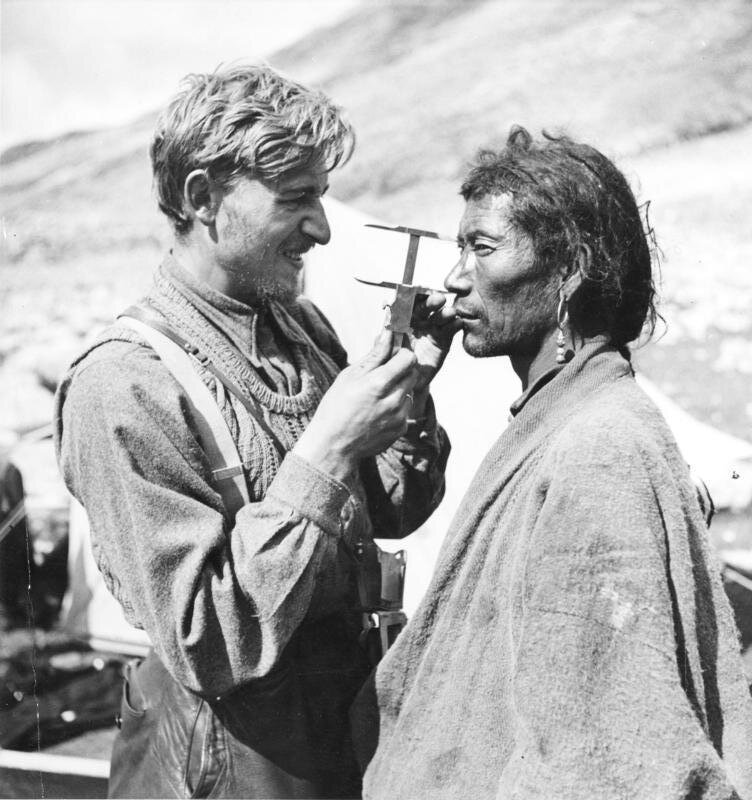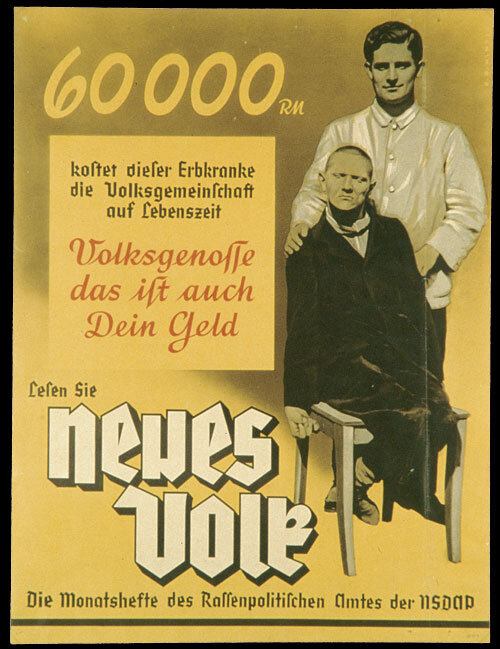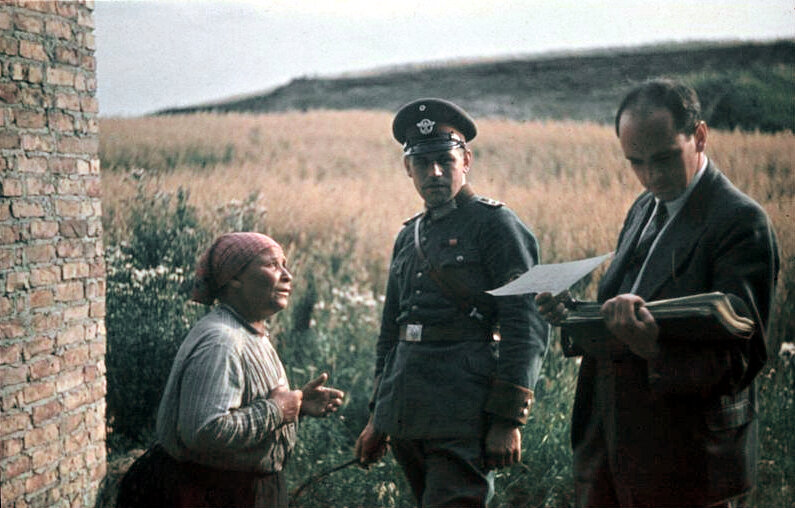#57 German Racism and her Intellectuals
A racist framework was the one broad set of ideas that everyone in Germany and Europe accepted as truth. The idea that white Germans were the ‘superior’ race developed in Germany tied in with European and American racist thinking. The Nazi reading of race came out of the work of Hans F. K. Gunther, who developed the Volk or Volkergruppe, people of a common hereditary with precise physical and spiritual habits. The concept of Aryan or Nordic races arose out of Gunther’s work.
Gunther's racial concept was then developed by Scandinavian and German intellectuals - Gustavus Adolphus, Franz Six, and others - into a historical formula that explained how a divided German people would come together and create a mythos of great new salvation for an oppressed nation, as the following quotation vividly illustrates:
"Although three hundred years have gone by since the period of the Thirty Years War (referring here to 1618-1648 wars where Germanic peoples united under the Lutheran religion and faced Catholic aggression) the political problem and the aim of our enemies have remained the same, the definite partitioning of Germany and annihilation of the Reich..... The period 1789-1815 represents the second 30 Years War.... in other words the war of German liberation.... German unity would now be at last realised... the German tribes had seen their hopes of imperial unity stolen by the nobility. The Foundation of the small German Reich by Bismarck in 1870-71 was indeed a huge leap forward... The third thirty years war started in 1914, The first world war did not reach any solutions... Today in 1942 we have reached the last stage of this third 30 Years War. The peace to come will bring the third 30 year war to a victorious conclusion there will be no half measures"
- Believe and Destroy: Intellectuals in the SS War Machine by Christian Ingrao, op cit page 56.
Here was the story of a three-hundred-year struggle that would bring the unity for German peoples out of the wilderness; it would signify a struggle of Nordic bloodlines against the rest of the world, towards a destiny created by providence. Claims to Nordic identity gave history its meaning, a regenerated Germanic world, collective salvation.
At first, in the middle of the 1930s, the aim was simply to expel ‘inferior’ peoples – such as Jewish people, Slavic people, members of the LGBT+ community, communists, disabled people and others – to ‘purify’ the Germanic people. Hitler and the people around him were well aware of the Turkish Holocaust and its aims to similarly ‘purify’ the Turkish people. As I argued in the previous blog, Hitler was following Ataturk's lead.
The 1939 War, Food, and the Slav Peoples
But the war in 1939 changed the racial framework in Germany entirely. Germany needed cheap or slave labour, something that ideologically racist people had once approved of. She needed more land to feed her people. Hunger and starvation had been the experience of the non-combatant in 1914-1918, hence the drive into the agriculturally rich lands of the Caucasus. And during the period before that goal was achieved, a shortage of food for the non-combatants was inevitable. Germany followed the British lead (during the Boer war 1903) in creating concentration camps. What was different here was the sheer scale of the death and destruction, and that this was done in the heart of Europe.
Hitler is supposed to have killed 6 million Jewish people. Ingrao's work shows that this estimate was vastly under-rated in terms of the planning of the SS. His book The Promise of the East illustrates that planning the drive eastwards into the Caucasus and both Eastern and Western Europe, Germany intended to ‘Germanise’ (that is, colonise) vast geographical areas, through deporting or exterminating all the non-Germanic populations. They planned to eradicate up to 70 million people.
This fact may startle readers of this blog. Germany’s war aims in 1939 did not come out of thin air. The German concept of Lebensraum or living space had long been a German goal. During the 1914-1918 war Germany had intentionally conquered parts of Poland, the arable land of Eastern Russia, Estonia, Latvia, Lithuania, and Ukraine which she had been forced to abandon at the Treaty of Versailles in 1919. At the time, this was also done in the name of Lebensraum.
The Greater Germanic Reich, to be realised with the policies of Lebensraum, had boundaries derived from the plans of the Generalplan Ost, the state administration, and the Schutzstaffel (SS).
Source: "Utopia: The 'Greater Germanic Reich of the German Nation'". Institut für Zeitgeschichte. München - Berlin. 1999. CC BY-SA 3.0. Retrieved from Wikimedia Commons.
Hitler had been a great admirer of the USA’s idea of ‘Manifest Destiny’ which involved territorial expansion and ethnic cleansing. In the context of the US, this involved nearly killing all the indigenous populations there, with this ideology being one of the driving forces. In 1939, it was Germany’s opportunity to do something similar, and to remake what had been lost in 1919. This was German eugenics, a movement popular across Europe and America at the time.
They prepared and started to move the German-speaking peoples of the Baltic states in 1939 to settle in the newly conquered areas of Poland. They prepared a racially-based humanitarian programme to herald the establishment of a German colonial system in the conquered territory. This was the beginning of the Lebensraum or ‘living space’ which was the beginning of the thousand-year Reich they dreamt of – the centre to the Nazi worldview of their racial utopia.
The extermination of Eastern and Western European Jewish peoples was to the Nazi way of thinking the hope and joy of building a new world, an alternative future, a revolutionary promise. Euthanasia also gained a place in the repertoire of eugenic racial engineering: a way of thinking that was popular across Europe. Eugenics was widely accepted as a way to reduce the ‘burden’ on society of incurable diseases and ‘inadequate peoples’. Nazism took this a step further with euthanasia.




‘Germanisation’ of the East: this was the building of the Nazi future, the repatriation of Volkdeutsch, the Germanic peoples. It involved:
"…Population selection management of territories, reception of migrants and refugees:
These were the main topics of those hectic weeks in September to November 1935 when the Nazi victories in Poland were starting to hope that they would be able to build a new order on renewed foundations"
Christian Ingrao, The Promise of the East, Polity 2016 page 4.
The plan was to expel 3.5 million Poles and replace them with 4.5 million Germans from the Baltic. The Poles were sent to Germany as labourers. Gypsies and Jews were expelled as 'undesirable ethnics'.
A fundamental prerequisite for the advent of a ‘racial utopia’, which was at the heart of the Nazi belief system, was an anti-Jewish policy. This was the prerequisite for the achievement of the Nazi Millennium, the return of Nordic blood to the by then extended Reich.
Chart to describe Nuremberg Laws of 15 September 1935 and the respective regulation of 14 November 1935. The "Nuremberg Laws" established a legal basis for racial identification. Only people with four non-Jewish German grandparents (four white circles in top row left) were of "German blood". A Jew was defined by the Nazis as someone who descended from three or four Jewish grandparents (black circles in top row right). In the middle stood people of "mixed blood" of the "first or second degree." A Jewish grandparent was defined as a person who was ever a member of a Jewish religious community. Also includes a list of allowed marriages ("Ehe gestattet") and forbidden marriages ("Ehe verboten"). From Wikimedia Commons.
Germany planned to occupy Alsace Lorraine in France, Ukraine and Crimea, Poland and the Baltic stat: all to be ‘Germanised’ and resettled from experts in racial selection. This was the Nazi future. They planned for a Nazi Europe including out to the East. They saw their future: Nordic, elitist and warlike. They had fully internalised the racial belief system. It was racial regeneration, they saw 600 million Nordic Germans occupying an immense territory, and this involved gigantic displacements, as well as the targeted murder, of many tens of millions of non-native ‘inferior’ peoples. When they could not handle the displaced, famine policies would be inaugurated so that people would die of starvation.
By the early 1930s, under the new Hitler regime, Germany was attempting to throw off the terms of Versailles and to reassert herself politically, socially, and economically: ‘inferior peoples’ needed to be eradicated. And Germany would have treated the people in the Caucasus in the same fashion had she successfully invaded and then settled the land with German-speaking people.
The Holocaust in Germany was part of the regeneration, as in the book of Exodus. As I have argued in previous blogs, Nazism was a millennialist movement par excellence. It had all the elements: a new messianic leader appearing from nowhere; a prophetic revelation that would lead the people out of suffering; a fundamental transformation of society; a ‘purifying’ theme that would create a single people as a whole. The entire edifice was themed in ideas that were prevalent across the expanding world of colonialism. It was, as it turned out, the final profanity of racism as the organising principle of empire.
Racism was too deeply embedded in the ideas of European and American culture to be discarded, even after the horrors of the 1939-1945 war. These ideas have endured to our day. But after the holocaust, these are present in a more subdued fashion. Racism is faith, as no one today can argue that it is either religion or science. It remains a belief system that has influenced people’s identity and the countries they inhabit. It was fundamental in explaining who we were, where we have come from, and how we should live with each other. Racism was as close to religion as we can get, without gods for support. Racism endures in a world where there are few alternatives and it has confused peoples in both the USA and UK in the 21st century, as both peoples struggle with the question of identity and whether their country is still a ‘great power’.
Copyright Notice. This blog is published under the Creative Commons licence. If anyone wishes to use any of the writing for scholarly or educational purposes they may do so as long as they correctly attribute the author and the blog. If anyone wishes to use the material for commercial purpose of any kind, permission must be granted from the author.











Ideology alone was of course not enough for Hitler to rise to power. The question remains: how was Hitler able to revive the German economy sufficiently to fight a global war in a mere six years? Hitler had taken political power in Germany in 1933. Once this question has been asked, the direction of the answer is obvious: the German economy would have to be supported by the great powers, France, Britain or America; there was no other way.